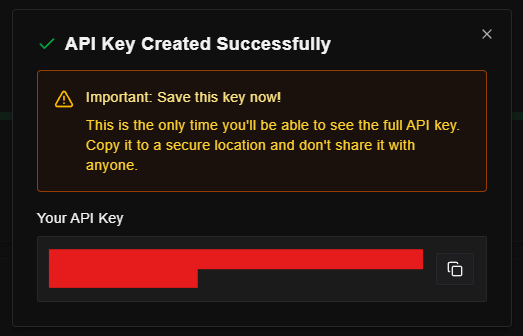API Documentation
Multex API Key
Learn how to create a new API key for your server
How to Create an API Key
To interact with the Multex API, you need to generate an API key for your server. This key authenticates your requests and ensures that only authorized users can access your server’s data.Steps to Generate an API Key
- Go to the Multex Dashboard Visit the Multex Dashboard and log in with your Discord account.
-
Click Create API Key
Enter an API key name, this can be anything you want.
From the list of servers you manage, select the server for which you want to generate an API key.
Note: You must have the appropriate permissions (e.g., server owner or admin) and your server must have an active Developer or Enterprise subscription.
Next, you will want to determine your API key’s scopes. Depending on what you want to access with the API key, you will need to select certain scopes. For example, if you want to GET discharges from your server, you will need theguild:readscope. Finally select an expiration date. API keys require an expiration date simply because the team behind Multex wants to ensure you follow best safety practices behind API keys in general. This protects our services and your server. -
Generate a New API Key
Click the Create API Key button.

-
Copy and Store Your API Key
Once generated, your API key will be displayed once. Copy it and store it securely.
Warning: Treat your API key like a password. If you lose it, you’ll need to generate a new one.

-
Use Your API Key in Requests
Include your API key in the
x-api-keyheader for all API requests:
Managing API Keys
- View Existing Keys: You can see a list of your active API keys in the dashboard.
- Delete Keys: If an API key is compromised or no longer needed, delete it immediately from the dashboard.
Never share your API key publicly or commit it to version control. Anyone with your key can access your server’s data.
API keys are scoped to a single server. If you manage multiple servers, generate a separate key for each one.
